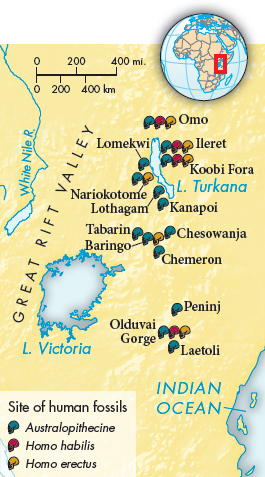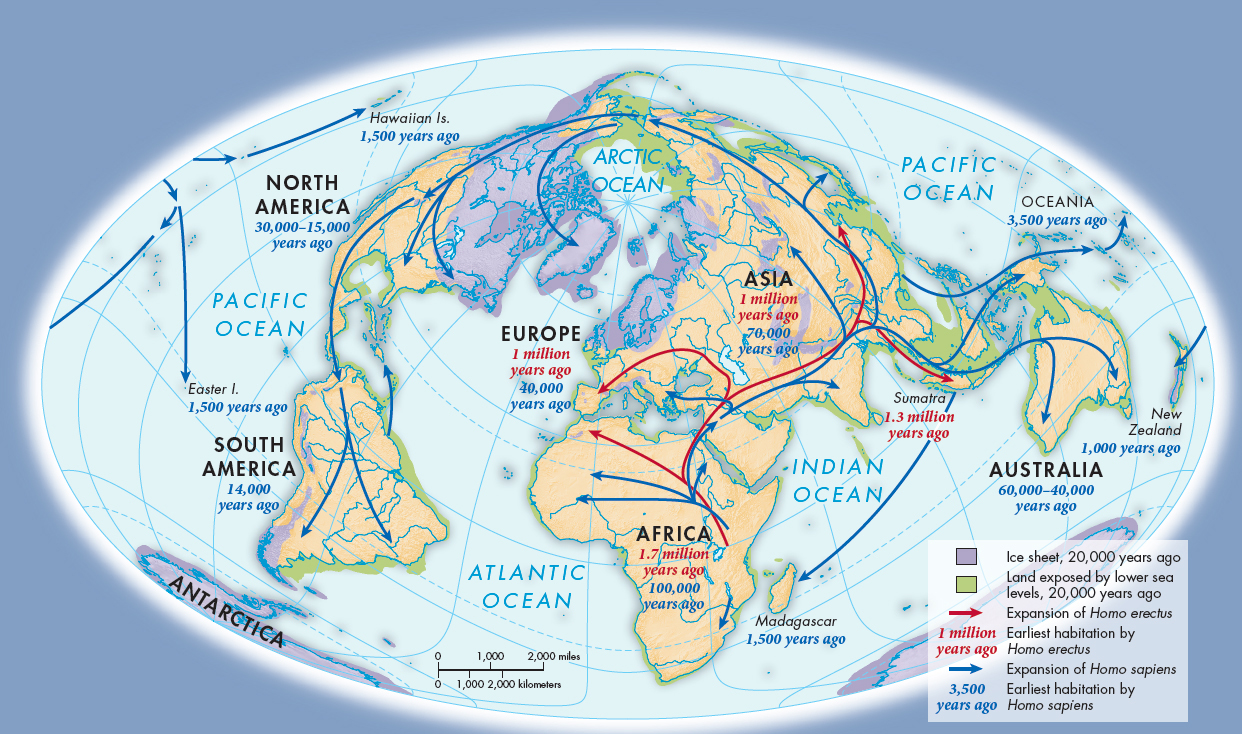Understanding World Societies:
Printed Page 6
Hominid Evolution
Using many different pieces of evidence from all over the world, archaeologists, paleontologists, and other scholars have developed a view of human evolution whose basic outline is widely shared, though there are disagreements about details. Most primates, including other hominids such as chimpanzees and gorillas, have lived primarily in trees, but at some point a group of hominids in East Africa began to spend more time on the ground, and between 6 and 7 million years ago they began to walk upright at least some of the time.

Over many generations, the skeletal and muscular structure of some hominids evolved to make upright walking easier, and they gradually became fully bipedal. The earliest fully bipedal hominids, whom paleontologists place in the genus Australopithecus, lived in southern and eastern Africa between 2.5 and 4 million years ago. Walking upright allowed australopithecines to carry and use things, which allowed them to survive better and may have also spurred brain development.
About 3.4 million years ago, some hominids began to use naturally occurring objects as tools, and sometime around 2.5 million years ago, one group of australopithecines in East Africa began to make and use simple tools, evolving into a different type of hominid that later paleontologists judged to be the first in the genus Homo. Called Homo habilis (“handy human”), they made sharpened stone pieces, which archaeologists call hand axes, and used them for various tasks. This suggests greater intelligence, and the skeletal remains support this, for Homo habilis had a larger brain than did the australopithecines.
About 2 million years ago, another species, called Homo erectus (“upright human”), evolved in East Africa. Homo erectus had still larger brains and made tools that were slightly specialized for various tasks, such as handheld axes, cleavers, and scrapers. Archaeological remains indicate that Homo erectus lived in larger groups than had earlier hominids and engaged in cooperative gathering, hunting, and food preparation. The location and shape of the larynx suggests that members of this species were able to make a wider range of sounds than were earlier hominids, so they may have relied more on vocal sounds than on gestures to communicate ideas to one another.
One of the activities that Homo erectus carried out most successfully was moving (Map 1.1). Gradually small groups migrated out of East Africa onto the open plains of central Africa, and from there into northern Africa. From 1 million to 2 million years ago, the earth’s climate was in a warming phase, and these hominids ranged still farther, moving into western Asia by as early as 1.8 million years ago. Bones and other materials from China and the island of Java in Indonesia indicate that Homo erectus had reached there by about 1.5 million years ago, migrating over large landmasses as well as along the coasts. (Sea levels were lower than they are today, and Java could be reached by walking.) Homo erectus also walked north, reaching what is now Spain by at least 800,000 years ago and what is now Germany by 500,000 years ago. In each of these places, Homo erectus adapted gathering and hunting techniques to the local environment, learning how to find new sources of plant food and how to best catch local animals.

ANALYZING THE MAP: What were the major similarities and differences between the migrations of Homo erectus and those of Homo sapiens? How did environmental factors shape human migration?CONNECTIONS: What types of technology were required for the migration patterns seen here? What do these migration patterns suggest about the social organization of early people?